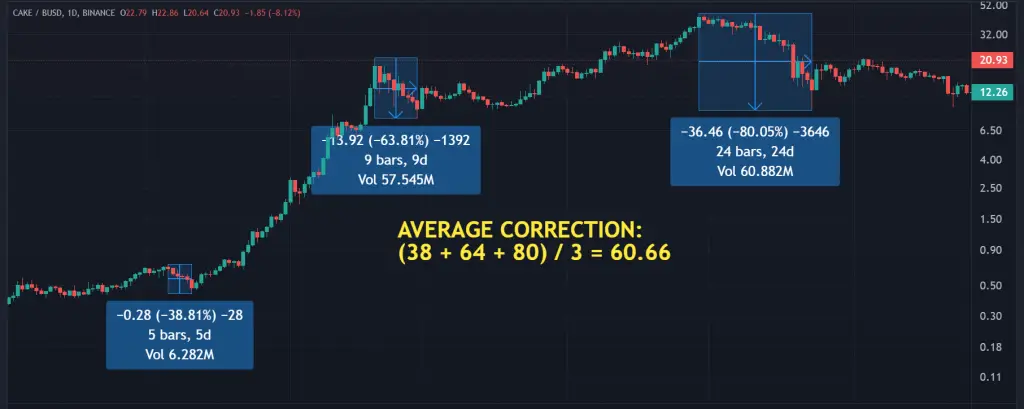Decentralized exchanges (DEXs)have witnessed an increase in popularity over the past few years. Users don’t want to register and deal with permissions on exchanges to trade top cryptocurrencies.
Two of the most popular decentralized crypto exchanges today are Uniswap and PancakeSwap. In this article, I will explore the Uniswap and PancakeSwap platforms, highlight key distinctions, and determine the superior DEX.
I’ll also look at the historical performance of the two and figure out which has historically been the better investment.
What is Uniswap?
Uniswap is a decentralized crypto exchange that utilizes the Uniswap protocol. This protocol enables automated transactions between ERC-20 tokens on the Ethereum blockchain. The protocol uses smart contracts, thus eliminating the need for intermediates (banks and companies) and the associated enforcement costs. Uniswap is the largest decentralized crypto exchange by daily trading volume.
What is PancakeSwap?
PancakeSwap is a decentralized exchange for the swapping BEP- 20 tokens built by anonymous developers. This DEX is built on the Binance Smart Chain platform and uses an automated market marker model. The AMM protocol prices assets according to a pricing algorithm. Instead of order books or bid/ask systems, you trade against a liquidity pool.
How Are PancakeSwap and Uniswap Similar?
· Automatic. Both exchanges utilize an automated market marker model.
· Earn a yield. Users can earn from providing liquidity on both platforms.
· Decentralized. Both exchanges use decentralized platforms.
· Community-driven. Both exchanges are community-governed and supported.
· Liquidity pools. Both exchanges utilize automated liquidity protocols.
· Browser wallet. Both exchanges require a browser wallet extension.
How Are PancakeSwap and Uniswap Different?
· Different chains. Uniswap operates on the Ethereum blockchain, while PancakeSwap runs on Binance Smart Chain.
· Native tokens. The native token on Uniswap is the UNI token, while the native toke on PancakeSwap is CAKE.
· Number of pairs. Uniswap supports a lot more trading pairs than PancakeSwap.
· Fees. Uniswap has slightly higher fees for token swaps than PancakeSwap due to higher gas fees.
· Economic model. Uniswap fees go entirely to liquidity providers, while PancakeSwap fees go to liquidity providers, PancakeSwap treasury, and token buyback.
· Speed. Transactions execute faster on the PancakeSwap platform than on Uniswap.
· Tokenomics. Uniswap has a supply cap of 1 billion UNI tokens, while PancakeSwap doesn’t have a supply cap, making CAKE an inflationary token.
· Additional features. The PancakeSwap platform features Lottery Tickets while Uniswap does not.
Comparing Uniswap and Pancakeswap:
Overall, both Uniswap and PancakeSwap are significant additions to the decentralized finance (DeFi) ecosystems. The permissionless AMM protocol eliminates the need to sign up and disclose your identity.
There is no central authority to block or seize my funds in either of the projects. However, I find that the Uniswap platform is more decentralized than PancakeSwap. Ethereum is generally more decentralized than BSC, which is a considerable advantage for Uniswap over PancakeSwap.
Uniswap benefits blockchain startups that want to directly release tokens to the market (through the Uniswap V2 router contract). This is because the platform doesn’t have listing fees and cumbersome vetting processes. Also, as a liquidity provider, I profit from simply placing my find in the liquidity pool.
One of the main drawbacks of Uniswap is the higher transaction fees. Since it utilizes the Ethereum network, network congestion and high gas prices drive the transaction fees up. And at least until ETH2, it can take longer for transactions to go through.
On the other hand, the gas price on PancakeSwap’s Binance Smart Chain is lower, encouraging smaller and cheaper transactions. In addition, PancakeSwap transactions execute much faster.
UNI vs CAKE: Historical Price Performance
Let’s look at the historical performance of the tokens UNI and CAKE, and compare them as investments.
I will look at the historical returns since December 2020, and compare how hard they correct when the general crypto market bleeds.
UNI historical returns: 578.16%
UNI has returned over 575% since December of 2020, which is equal to a 6.75x ROI:
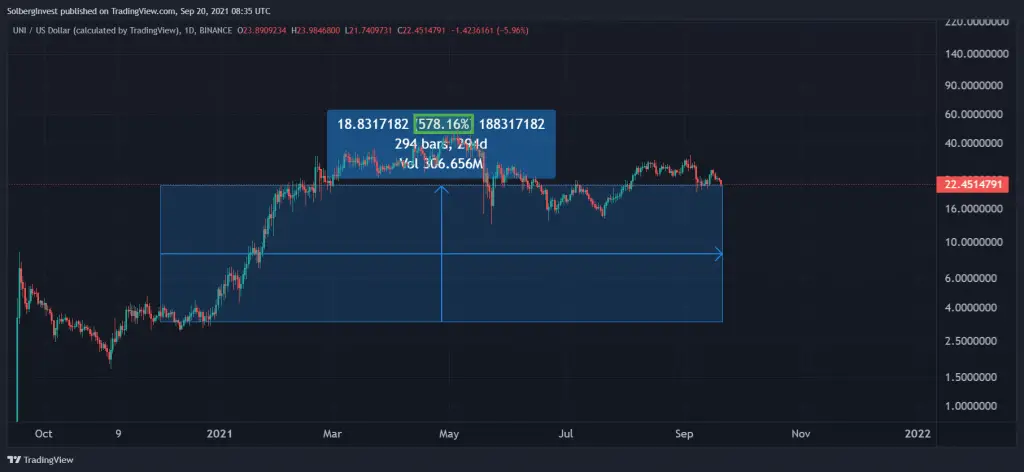
These are good returns, but as you’ll see soon, it’s nothing compared to CAKE. Before we look at the historical returns of CAKE, let’s look at how stark the corrections have been for UNI:
UNI correction: 51.33%
There have been three substantial corrections since December of 2020 (at the time of writing). These can be seen on the chart below:
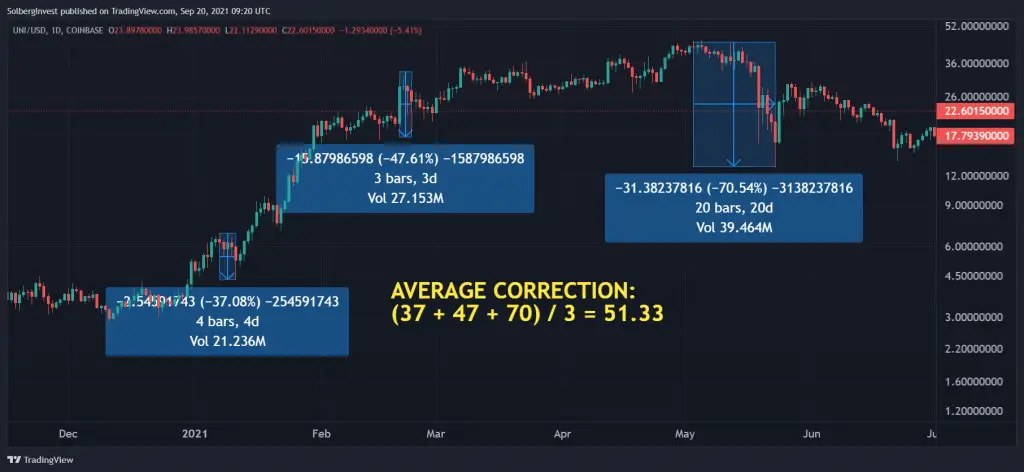
The average of these three corrections is 51.33%. This does NOT mean that most corrections are roughly 50%. It just means that the average of the three corrections was 50% in this narrow time window.
To summarize UNI’s performance:
- 578.16% returns
- 50% correction (average)
Let’s look at how CAKE performed in comparison:
CAKE historical performance: 5962.01%
CACKE has returned almost 6000%, which is equal to a 61x ROI (roughly). See the chart below:
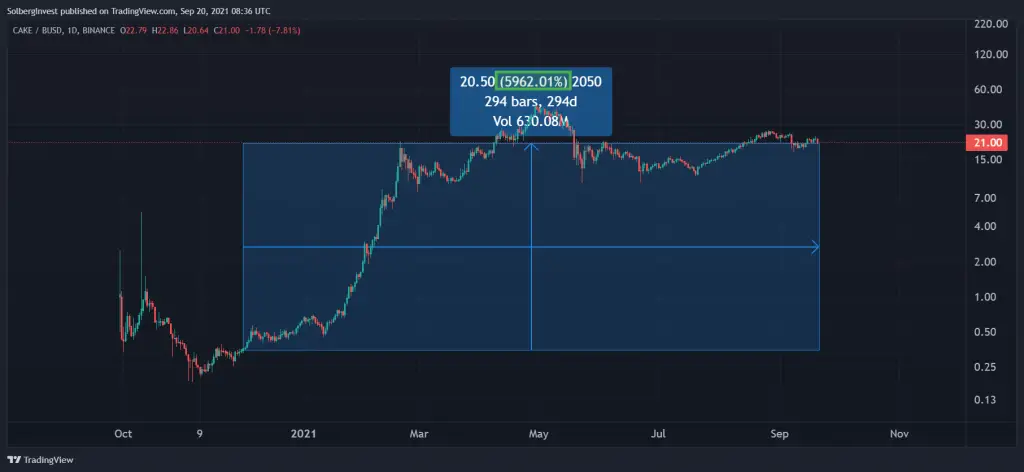
The returns CACKE has produced are roughly 10x the returns from UNI, and that’s a significant difference.
- If you invested 10,000 USD in Uniswap in December of 2020 you would have 67,500 USD today.
- If you invested 10,000 USD in PancackeSwap in December of 2020 you would have 610,000 USD today.
Before you run away with CAKE and ditch UNI, you need to think about this:
Uniswap is more established and had already surged before December of 2020. This means that the chosen time frame was favorable for CAKE. Also, historical performance does not guarantee future performance. Actually, it’s often a good idea to pay attention to those projects that have performed mediocre but have strong fundamentals, as they will likely surge once the hype returns.
Oh, by the way:
I have a free newsletter you can sign up to where I send out technical analyses on Ethereum from time to time; check it out:
Okay, but CACKE still wins the historical returns (by far). Let’s take a look at the historical risk of investing in CACKE:
CAKE correction: 60.66%
CAKE has on average 20% worse corrections than UNI, and this indicates a significantly higher risk. If you time the market poorly, you might need a 5x to break even.
Think about it like this: 80% down means going from 1 USD to 0.2 USD. To go from 0.2 USD back up to 1 USD, you need a 5x. A big part of becoming wealthy is not losing money, as losing money is often worse than gaining because of the math above.
Below you see the three corrections:
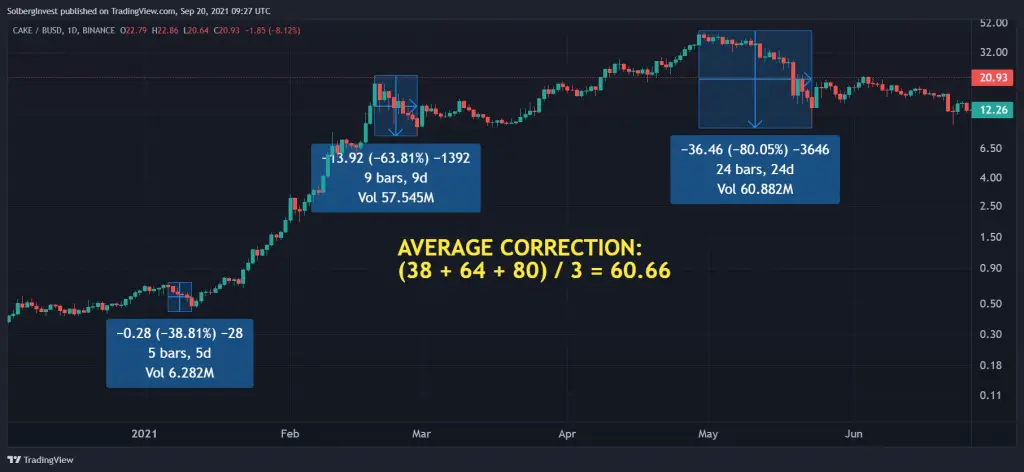
This is much worse than UNI. This might also be a function of the age difference between the projects. CACKE might be more volatile because it is smaller and younger.
Nevertheless, UNI wins the risk test.
PS:
If you have invested in or consider investing in Ethereum, you need to read this article right now: My personal Ethereum investing and trading strategy.
Conclusion:
Best exchange: PancakeSwap, but it depends on your needs.
In my opinion, it comes down to the existence of a specific pair or token I might be looking for, what I’m trying to achieve, and my strategy (optimizing yield, smaller, faster transactions, and minimizing fees). These considerations and the extra platform features make PancakeSwap the better DEX, at least until the transition to ETH2 fixes the scalability, transaction fees, and speed drawbacks of Uniswap.
Best investment: CAKE, but UNI if you don’t like risk.
PancakeSwap’s CAKE token has produced almost 10x the returns, but it’s way riskier than Uniswap’s UNI. Therefore, Pancaceswap is the best investment for those who like to take additional risks, but UNI is better for the more cautious (if they exist in the crypto markets…)
(all charts from tradingview, none of this is financial advice, just my personal opinion)
Grab My Free Guide – Increase Your Returns!
When investing in cryptocurrencies, there are sneaky ways to multiply your returns significantly. I’ve written about four of them and given them to you FOR FREE in this guide:
